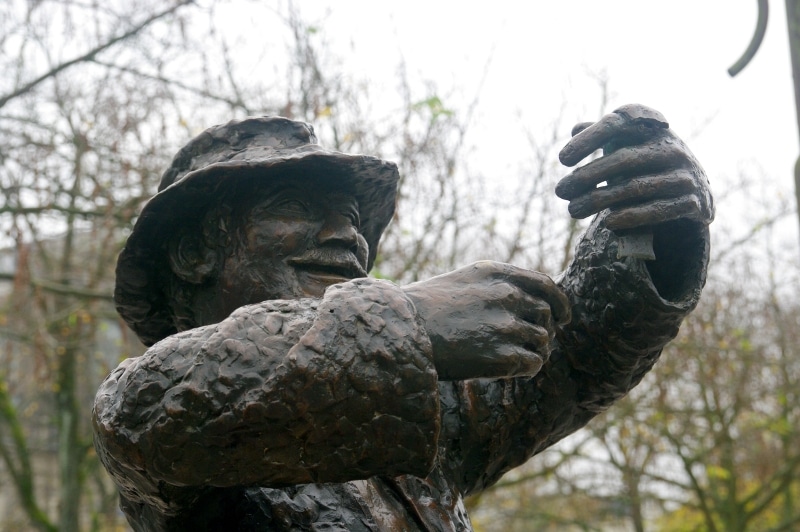There are many statues of famous people in Amsterdam.
On your trip, you won't be able to avoid its monuments.
Today, I'm talking about it.
Statue in Amsterdam: article summary
- Statue in Amsterdam: Kokadorus on the Amstelveld
- Thorbecke statue on Thorbeckeplein
- Statue in Amsterdam: De Volksvrouw Marnixplein
- Anne Frank at the Westermarkt
- Statue in Amsterdam: Theo Thijssen Lindengracht
- Woutertje Pieterse and Femke Noordermarkt
- Statue in Amsterdam: Multatuli on the Torensluis Amsterdam
- Place Johnny Jordaan
Statue in Amsterdam: Kokadorus on the Amstelveld
Kokadorus, born in Leeuwarden, moved to Amsterdam when he was very young. He used to sell matches in Kalverstraat, but when he realized he was selling well, he set up a street-selling stall.
The story goes that he was invited by King Willem III to speak at the Paleis Het Loo (palace). When he got there, he fell silent because of all the luxury, and couldn't speak as he used to. Since 1906, his name was Professor Kokadorus.
There are many mysteries surrounding the origin of this name. It may be a combination of the names of his grandfather Ko, his grandmother Ka and his father Dorus, but in reality these people seem to have had other names. The statue shows Kokadorus praising the quality of his suspenders.

Thorbecke statue on Thorbeckeplein
Johan Rudolph Thorbecke is the founder of democracy in the Netherlands. In 1848, King Willem II ordered Thorbecke to rewrite the constitution.
Through direct elections, the people gained more power, leading to the modern state and democracy as we know it today.
Thorbecke was Foreign Minister on three occasions. The statue appeared four years after his death, on May 18, 1876. Thorbecke holds a briefcase under the arm and the Constitution in hand. The statue stands on Thorbeckeplein, opposite Reguliersgracht.
Statue in Amsterdam: De Volksvrouw Marnixplein
Tonia Sluyter modeled this statue called De Volksvrouw (The Folk Women). It represents all the women who have made it through the crisis. The woman looks on a strong look at the Lijnbaansgracht and radiates strength with crossed arms.
Because of her modest lifestyle, Tonia Sluyter was unable to create anything other than a plaster statue. However, in 1967, the plaster model was cast in bronze and placed on the Marnixplein.
Anne Frank at the Westermarkt
Just a few metres from the Frank family homeOn the corner of Prinsengracht and Westermarkt, this bronze statue commemorates the life of 15-year-old Anne Frank, murdered in the Bergen-Belsen concentration camp. during the Second World War.
The statue was unveiled on March 14, 1977 by Mayor Samkalden. People suspect that March 14 is the day of Anne Frank's death.
The statue shows Anne with her hands on her back as she looks up hopefully, as we know it from the newspapers.
Statue in Amsterdam: Theo Thijssen Lindengracht
On the occasion of writer Theo Thijssen's 100ᵉ birthday, his statue was unveiled by then Mayor Wim Polak. Theo Thijssen is best known for the novel "Kees de Jongen".
Theo Thijssen was much more than a writer. He was a teacher, trade unionist, Social Democrat MP and a true resident of Jordaan. Born here as the son of a cleaning lady, he went to the Rijkskweekschool voor Onderwijzers at Haarlem with a government grant.
Woutertje Pieterse and Femke Noordermarkt
The statue was erected in honor of "Woutertje Pieterse", a Dutch bestseller written by Multatuli. It was Multatuli's second novel and one of his best-known after "Max Havelaar".
Initially, Multatuli didn't want to publish the book. His widow did so after his death, so it was never a success.
Woutertje Pieterse is an Amsterdam boy with lots of dreams and curiosity. In the book, he protects Femke from a gang of bad boys and receives a kiss as a reward.
This took place on the Noordermarkt, which is why the statue of the two figures is here.
Statue in Amsterdam: Multatuli on the Torensluis Amsterdam
The statue, unveiled by Queen Beatrix, was erected to mark the 100th anniversary of the death of Eduard Douwes Dekker, who wrote under the pseudonym Multatuli. His most famous work is "Max Havelaar".
Just a few blocks away is the address mentioned by Dekker in Max Havelaar. At that time a monastery was located at this address, so there was no café.
Here, you'll find houses with a sign next to the door bearing the name of the coffee merchant. A sort of nod to the novel.
Place Johnny Jordaan
This square is entirely dedicated to Amsterdam's most famous folk singers. After Johnny Jordaan's death in 1989, local residents set up a fund to raise money for a statue. The statue was erected a few years later.
In 1991, an initiative was launched to name this part of the River Jordan after the folk singer. Shortly afterwards, the Johnny Jordaanplein was a reality.
Later, other statues were added, including those of Tante Leen (1994), Johnny Meijer (1996), Manke Nelis (2005) and Bolle Jan and Mien Froger (2010).
There are many statues to see in Amsterdam. You won't want to miss them on your visit. What you discover the heroes who gave the city its soul.
What to do in Amsterdam in 1 day, 2 days, 3 days, 5 days, a week?
Whatever the length of your stay, I invite you to download my special Amsterdam guide.
It's free and in PDF format.
All you have to do is tell me below which e-mail address you'd like to receive it at.
EDIT: you can't enter your email?
Take the quiz at the top of this article and you'll be able to register your email address to receive the special Amsterdam guide!
Leave a Reply